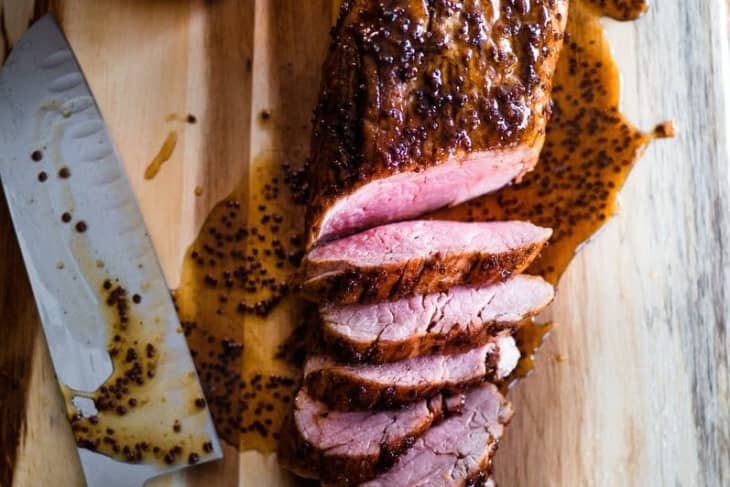Kitchn’s Top 10 Things to Know About Cooking Pork Tenderloin
Pork tenderloin is the all-star of weeknight dinners. From the affordable price tag to its impressive versatility and ease of cooking, this is one cut of pork that truly delivers. Before you step into the kitchen, arm yourself with the 10 most important things you need to know about cooking pork tenderloin. The next time you make it, it’ll be your best yet.
1. Take a few minutes to remove the silver skin first.
Silver skin, named for its silver-white color, is a thin membrane of connective tissue found on pork tenderloin. It doesn’t dissolve when cooked, so when it’s not removed it adds a tough and chewy texture. Use a thin, flexible knife to cut and remove it, or ask your butcher to take care of it for you.
Learn more: What Exactly Is Silver Skin?
2. Give it a good brine.
Pork tenderloin is a super-lean cut of meat with the potential to dry out quickly when cooked for even just a couple minutes too long. Brining ensures the meat stays tender, juicy, and well-seasoned.
3. Use a 2-step process for cooking perfect pork tenderloin.
One more reason to love pork tenderloin? Rather than having to reach for a recipe, you just need to remember this simple two-step process: Sear and then roast the meat for perfect results every time. Searing the meat first gives it that golden-brown crust before a quick roast in the oven finishes it off.
4. When searing, start with a screaming-hot skillet.
For the seared crust that makes roasted pork tenderloin totally irresistible, always start with a super-hot skillet. Place the skillet in the oven as it preheats for 10 to 20 minutes before cooking.
Learn more: How To Make Roasted Pork Tenderloin
5. Allow 30 minutes for cooking.
Part of the beauty of this ultra-tender cut is how quickly and easily it makes its way to the table. Whether you roast it, sear it, or stir-fry it, pork tenderloin is a meat to lean on for easy 30-minute meals.
6. It has the potential to be a one-pan meal.
Beyond its 30-minute meal status, the beauty of roasting pork tenderloin is that it’s so easy to round it out with a side for a one-pan meal. After searing the meat in a skillet, add beans, veggies, apples, or even biscuits to the skillet before popping it into the oven for the final 10 to 12 minutes of cooking.
7. Use it in stir-fries that call for pork chops or cutlets.
Because of its lean, quick-cooking nature, pork tenderloin lends itself well to stir-fries. In fact, when it comes to stir-fries, pork tenderloin can be used interchangeably with pork chops or cutlets. Have a stir-fry recipe that call for pork chops? Cut a tenderloin into 1/2-inch rounds and then slice each piece into two to three strips to swap it in.
Get a recipe: Pork and Cabbage Stir-Fry
8. Don’t worry too much about pink meat.
Yes, a little bit of pink is perfectly fine. For pork tenderloin, as with all meat, internal temperature (not color) is the best indicator of doneness.
9. Cook pork tenderloin to 145°F.
Measuring internal temperature with a probe thermometer is the best way to measure the doneness of pork tenderloin. Cooked to 145°F, the meat is tender, juicy, and just a touch pink.
10. Reheat without drying it out.
To prevent disappointing, dried-out meat, reheat pork tenderloin by giving it a second sear over medium-high heat in a cast iron skillet on the stovetop. The meat reheats quickly before it has a chance to dry out. If you’re worried things are still looking dry, add a splash of water or stock to the pan. The instant burst of steam will add some extra moisture, so you get juicy slices of pork a second time around.
